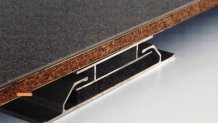If the 2005 Fall Out Boy album "From Under the Cork Tree" was not on your radar, you might not know that the cork in your champagne bottle came from a tree.
Cork trees have been cultivated across the Mediterranean region for thousands of years, harvested every nine years for their bark to make wine stoppers and other products.
Cork trees also can be a barrier against desertification, and they have been considered a conservation “priority” in Portugal by the World Wildlife Foundation. Researchers who study forests have said growing more cork trees in Portugal could reduce the desertification, and the trees help hold rainfall and keep the soil stable while building the habitat for animals in the region.
But cork is being used in new ways besides just wine bottles. In the Connect the Dots series, you learn that cork has a variety of other uses — in train cars, home flooring, studios, and sneakers and Birkenstocks.
“It's a cellular material. So if you take a piece of it and you look at it under the microscope, it looks like a honeycomb,” said Kim Roddis, a civil and environmental engineering professor at George Washington University. “That's the only thing that's solid. That's about 15% of the cork. And the rest of it's air.”
Cork stoppers for wine and champagne bottles make up 70% of the business of the Portuguese company Corticeira Amorim, the largest cork company in the world and one of the longest-operating in the industry.
But the company is seeing increased interest in its construction and infrastructure-related cork products, said António Amorim, the CEO.
Siemens, the manufacturing company, makes train cars with Amorim cork subfloors.

Having cork floors reduces the amount of embodied carbon in each car, in other words, use of metals or other building materials that came from carbon-emitting processes, Roddis said. Additionally, by making the car lighter, less fuel is needed to move it, reducing emissions.
Amorim touted the emissions benefits of harvesting the bark from cork trees. And according to industry sources and the World Wildlife Foundation, after cork trees are harvested, they take in more carbon to rebuild their bark. A harvested cork tree can take in up to five times as much carbon as an unharvested one.
Cork is also combined with Nike Grind, a composite material made of ground-up bits of discarded Nike shoes, scrap and other materials. Floor underlays made of cork and Nike Grind can help the acoustics in a building, while reusing the waste from Nike’s manufacturing and preventing some discarded clothing from going to a landfill.
“We really conclude the circle of the circular economy, not wasting anything,” says Amorim.
He said he is grateful for all the cork tree has done for his family. “We think it’s a gift of nature,” Amorim said.
FUN FACTS
Urban legends say Dom Perignon, the French Benedictine monk after whom the expensive champagne is named, was the first person to stop a bottle using cork.
There is a far earlier connection in history, though — the ancient Romans were using cork as stoppers for their amphorae full of olive oil as they moved the goods through the empire. (An amphora is kind of like a vase, and is used to hold liquids like oil or wine.)

